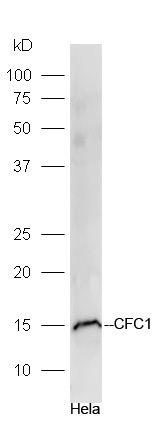产品货号 : mlR13873
英文名称 : CFC1
中文名称 : 内脏移位线管蛋白CFC1蛋白抗体
别 名 : CFC 1; CFC1; CFC1_HUMAN; CFC1B; CR 1; Cripto 1; Cripto; Cripto FRL 1 cryptic family 1; CRYPTIC; Cryptic family 1; Cryptic family protein 1; Cryptic gene; Cryptic protein; DTGA2; FLJ77897; FRL 1; HTX2; MGC133213.
研究领域 : 细胞生物 发育生物学 信号转导 生长因子和激素
抗体来源 : Rabbit
克隆类型 : Polyclonal
交叉反应 : Human,
产品应用 : WB=1:500-2000 ELISA=1:500-1000 IHC-P=1:400-800 IHC-F=1:400-800 ICC=1:100-500 IF=1:100-500 (石蜡切片需做抗原修复)
not yet tested in other applications.
optimal dilutions/concentrations should be determined by the end user.
分 子 量 : 15kDa
细胞定位 : 细胞膜 分泌型蛋白
性 状 : Lyophilized or Liquid
浓 度 : 1mg/ml
免 疫 原 : KLH conjugated synthetic peptide derived from human CFC1:1-100/223
亚 型 : IgG
纯化方法 : affinity purified by Protein A
储 存 液 : 0.01M TBS(pH7.4) with 1% BSA, 0.03% Proclin300 and 50% Glycerol.
保存条件 : Store at -20 °C for one year. Avoid repeated freeze/thaw cycles. The lyophilized antibody is stable at room temperature for at least one month and for greater than a year when kept at -20°C. When reconstituted in sterile pH 7.4 0.01M PBS or diluent of antibody the antibody is stable for at least two weeks at 2-4 °C.
PubMed : PubMed
产品介绍 : This gene encodes a member of the epidermal growth factor (EGF)- Cripto, Frl-1, and Cryptic (CFC) family, which are involved in signalling during embryonic development. Proteins in this family share a variant EGF-like motif, a conserved cysteine-rich domain, and a C-terminal hydrophobic region. The protein encoded by this gene is necessary for patterning the left-right embryonic axis. Mutations in this gene are associated with defects in organ development, including autosomal visceral heterotaxy and congenital heart disease. Alternatively spliced transcript variants encoding multiple isoforms have been observed for this gene. [provided by RefSeq, Jul 2012]
Function:
NODAL coreceptor involved in the correct establishment of the left-right axis. May play a role in mesoderm and/or neural patterning during gastrulation.
Subcellular Location:
Cell membrane. Secreted. Does not exhibit a typical GPI-signal sequence. The C-ter hydrophilic extension of the GPI-signal sequence reduces the efficiency of processing and could lead to the production of an secreted unprocessed form. This extension is found only in primates.
Post-translational modifications:
N-glycosylated.
DISEASE:
Heterotaxy, visceral, 2, autosomal (HTX2) [MIM:605376]: A form of visceral heterotaxy, a complex disorder due to disruption of the normal left-right asymmetry of the thoracoabdominal organs. Visceral heterotaxy or situs ambiguus results in randomization of the placement of visceral organs, including the heart, lungs, liver, spleen, and stomach. The organs are oriented randomly with respect to the left-right axis and with respect to one another. It can been associated with variety of congenital defects including cardiac malformations. Note=The disease is caused by mutations affecting the gene represented in this entry.
Transposition of the great arteries dextro-looped 2 (DTGA2) [MIM:613853]: A congenital heart defect consisting of complete inversion of the great vessels, so that the aorta incorrectly arises from the right ventricle and the pulmonary artery incorrectly arises from the left ventricle. This creates completely separate pulmonary and systemic circulatory systems, an arrangement that is incompatible with life. The presence or absence of associated cardiac anomalies defines the clinical presentation and surgical management of patients with transposition of the great arteries. Note=The disease is caused by mutations affecting the gene represented in this entry.
Conotruncal heart malformations (CTHM) [MIM:217095]: A group of congenital heart defects involving the outflow tracts. Examples include truncus arteriosus communis, double-outlet right ventricle and transposition of great arteries. Truncus arteriosus communis is characterized by a single outflow tract instead of a separate aorta and pulmonary artery. In transposition of the great arteries, the aorta arises from the right ventricle and the pulmonary artery from the left ventricle. In double outlet of the right ventricle, both the pulmonary artery and aorta arise from the right ventric
Similarity:
Contains 1 EGF-like domain.
SWISS:
P0CG37
Gene ID:
55997
Important Note:
This product as supplied is intended for research use only, not for use in human, therapeutic or diagnostic applications.
产品图片












